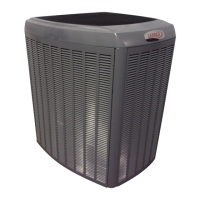Page 3
XC15 SERIES
XC15 Outdoor Unit
The XC15 Air Conditioners, which will also be referred to in
this instruction as the outdoor unit, uses HFC−410A
refrigerant. This outdoor unit must be installed with a
matching indoor unit and line set as outlined in the Lennox
XC15 Engineering Handbook.
This outdoor unit is designed for use in systems that use
thermal expansion valve (TXV) refrigerant metering
devices.
General Information
These instructions are intended as a general guide and do
not supersede local codes in any way. Consult authorities
who have jurisdiction before installation.
When servicing or repairing HVAC components, ensure
caps and fasteners are appropriately tightened. Table 1
lists torque values for typical service and repair items.
Table 1. Torque Requirements
Part Recommended Torque
Service valve cap 8 ft.− lb. 11 NM
Sheet metal screws 16 in.− lb. 2 NM
Machine screws #10 28 in.− lb. 3 NM
Compressor bolts 90 in.− lb. 10 NM
Gauge port seal cap 8 ft.− lb. 11 NM
USING MANIFOLD GAUGE SETS
When checking the system charge, only use a manifold
gauge set that features low−loss anti−blow back fittings.
See figure 4 for a typical manifold gauge connection setup.
Manifold gauge sets used with HFC−410A refrigerant
systems must be capable of handling the higher system
operating pressures. The gauges should be rated for use
with pressures of 0 − 800 on the high side and a low side of
30" vacuum to 250 psi with dampened speed to 500 psi.
Gauge hoses must be rated for use at up to 800 psi of
pressure with a 4000 psi burst rating.
OPERATING SERVICE VALVES
The liquid and suction line service valves are used for
removing refrigerant, flushing, leak testing, evacuating,
checking charge and charging.
Each service valve is equipped with a service port which
has a factory−installed valve stem.
IMPORTANT
Only use Allen wrenches of sufficient hardness
(50Rc − Rockwell Harness Scale minimum). Fully
insert the wrench into the valve stem recess.
Service valve stems are factory−torqued (from 9
ft−lbs for small valves, to 25 ft−lbs for large valves) to
prevent refrigerant loss during shipping and
handling. Using an Allen wrench rated at less than
50Rc risks rounding or breaking off the wrench, or
stripping the valve stem recess.
1
2
3
4
5
6
7
8
9
10
11
12
1/6 TURN
1
2
3
4
5
6
7
8
9
10
11
12
1/12 TURN
Figure 2. Cap Tightening Distances
NOTE − A label with specific torque requirements may be
affixed to the stem cap. If the label is present, use the
specified torque.
IMPORTANT
To prevent stripping of the various caps used, the
appropriately sized wrench should be used and
fitted snugly over the cap before tightening.
To Access Angle−Type Service Port:
A service port cap protects the service port core from
contamination and serves as the primary leak seal.
(VALVE STEM SHOWN
CLOSED) INSERT HEX
WRENCH HERE
VALVE STEM
FRONT-SEATED
TO OUTDOOR UNIT
SERVICE PORT
CORE
TO INDOOR
UNIT
SERVICE PORT
SERVICE PORT CAP
CLOSED TO BOTH
INDOOR AND
OUTDOOR UNITS
STEM CAP
Figure 3. Angle−Type Service Valve
(Font−Seated Closed)
1. Remove service port cap with an appropriately sized
wrench.
2. Connect gauge to the service port.
3. When testing is completed, replace service port cap and
tighten as follows:
S With Torque Wrench: Finger tighten and then
tighten per table 1.
S Without Torque Wrench: Finger tighten and use an
appropriately sized wrench to turn an additional
1/6 turn clockwise as illustrated in figure 2.
To Open and Close Angle−Type Service Valve:
A valve stem cap protects the valve stem from
contamination and assures a leak−free seal.

